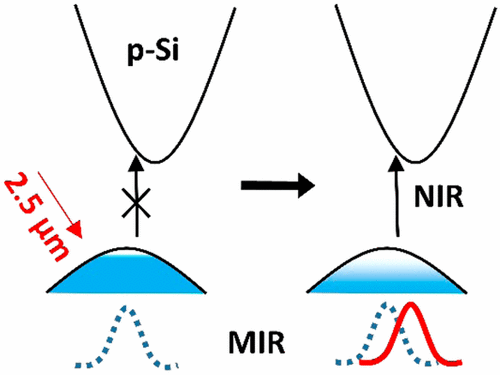当前位置:
X-MOL 学术
›
Nano Lett.
›
论文详情
Our official English website, www.x-mol.net, welcomes your
feedback! (Note: you will need to create a separate account there.)
Ultrafast Silicon Photonics with Visible to Mid-Infrared Pumping of Silicon Nanocrystals
Nano Letters ( IF 9.6 ) Pub Date : 2017-09-18 00:00:00 , DOI: 10.1021/acs.nanolett.7b03393 Benjamin T. Diroll 1 , Katelyn S. Schramke 2 , Peijun Guo 1 , Uwe R. Kortshagen 2 , Richard D. Schaller 1, 3
Nano Letters ( IF 9.6 ) Pub Date : 2017-09-18 00:00:00 , DOI: 10.1021/acs.nanolett.7b03393 Benjamin T. Diroll 1 , Katelyn S. Schramke 2 , Peijun Guo 1 , Uwe R. Kortshagen 2 , Richard D. Schaller 1, 3
Affiliation

|
Dynamic optical control of infrared (IR) transparency and refractive index is achieved using boron-doped silicon nanocrystals excited with mid-IR optical pulses. Unlike previous silicon-based optical switches, large changes in transmittance are achieved without a fabricated structure by exploiting strong light coupling of the localized surface plasmon resonance (LSPR) produced from free holes of p-type silicon nanocrystals. The choice of optical excitation wavelength allows for selectivity between hole heating and carrier generation through intraband or interband photoexcitation, respectively. Mid-IR optical pumping heats the free holes of p-Si nanocrystals to effective temperatures greater than 3500 K. Increases of the hole effective mass at high effective hole temperatures lead to a subpicosecond change of the dielectric function, resulting in a redshift of the LSPR, modulating mid-IR transmission by as much as 27%, and increasing the index of refraction by more than 0.1 in the mid-IR. Low hole heat capacity dictates subpicosecond hole cooling, substantially faster than carrier recombination, and negligible heating of the Si lattice, permitting mid-IR optical switching at terahertz repetition frequencies. Further, the energetic distribution of holes at high effective temperatures partially reverses the Burstein–Moss effect, permitting the modulation of transmittance at telecommunications wavelengths. The results presented here show that doped silicon, particularly in micro- or nanostructures, is a promising dynamic metamaterial for ultrafast IR photonics.
中文翻译:

具有硅纳米晶体可见到中红外泵浦的超快硅光子学
使用中红外光脉冲激发的掺硼硅纳米晶体,可以实现对红外(IR)透明度和折射率的动态光学控制。与先前的基于硅的光开关不同,通过利用由p型硅纳米晶体的自由孔产生的局部表面等离振子共振(LSPR)的强光耦合,无需制造结构即可实现透射率的大变化。光激发波长的选择允许在空穴加热和通过带内或带间光激发分别产生载流子之间的选择性。中红外光泵浦将p-Si纳米晶体的自由空穴加热到大于3500 K的有效温度。在有效空穴温度高的情况下,空穴有效质量的增加导致介电函数的亚皮秒级变化,导致LSPR发生红移,将中间IR传输调制多达27%,并且在中间IR中将折射率提高了0.1以上。低的空穴热容量决定了亚皮秒级的空穴冷却,比载流子重组快得多,并且硅晶格的热量可以忽略不计,从而允许以太赫兹重复频率进行中红外光学转换。此外,空穴在高有效温度下的高能分布会部分逆转Burstein-Moss效应,从而可以调制电信波长下的透射率。此处显示的结果表明,掺杂的硅,特别是在微米或纳米结构中,是超快IR光子学的有希望的动态超材料。并在中红外使折射率提高了0.1以上。低的空穴热容量决定了亚皮秒级的空穴冷却,比载流子重组快得多,并且硅晶格的热量可以忽略不计,从而允许以太赫兹重复频率进行中红外光学转换。此外,空穴在高有效温度下的高能分布会部分逆转Burstein-Moss效应,从而可以调制电信波长下的透射率。此处显示的结果表明,掺杂的硅,特别是在微米或纳米结构中,是超快IR光子学的有希望的动态超材料。并在中红外使折射率提高了0.1以上。低的空穴热容量决定了亚皮秒级的空穴冷却,比载流子重组快得多,并且硅晶格的热量可以忽略不计,从而允许以太赫兹重复频率进行中红外光学转换。此外,空穴在高有效温度下的高能分布会部分逆转Burstein-Moss效应,从而可以调制电信波长下的透射率。此处显示的结果表明,掺杂的硅,特别是在微米或纳米结构中,是超快IR光子学的有希望的动态超材料。允许以太赫兹重复频率进行中红外光切换。此外,空穴在高有效温度下的高能分布会部分逆转Burstein-Moss效应,从而可以调制电信波长下的透射率。此处显示的结果表明,掺杂的硅,特别是在微米或纳米结构中,是超快IR光子学的有希望的动态超材料。允许以太赫兹重复频率进行中红外光切换。此外,空穴在高有效温度下的高能分布会部分逆转Burstein-Moss效应,从而可以调制电信波长下的透射率。此处显示的结果表明,掺杂的硅,特别是在微米或纳米结构中,是超快IR光子学的有希望的动态超材料。
更新日期:2017-09-19
中文翻译:

具有硅纳米晶体可见到中红外泵浦的超快硅光子学
使用中红外光脉冲激发的掺硼硅纳米晶体,可以实现对红外(IR)透明度和折射率的动态光学控制。与先前的基于硅的光开关不同,通过利用由p型硅纳米晶体的自由孔产生的局部表面等离振子共振(LSPR)的强光耦合,无需制造结构即可实现透射率的大变化。光激发波长的选择允许在空穴加热和通过带内或带间光激发分别产生载流子之间的选择性。中红外光泵浦将p-Si纳米晶体的自由空穴加热到大于3500 K的有效温度。在有效空穴温度高的情况下,空穴有效质量的增加导致介电函数的亚皮秒级变化,导致LSPR发生红移,将中间IR传输调制多达27%,并且在中间IR中将折射率提高了0.1以上。低的空穴热容量决定了亚皮秒级的空穴冷却,比载流子重组快得多,并且硅晶格的热量可以忽略不计,从而允许以太赫兹重复频率进行中红外光学转换。此外,空穴在高有效温度下的高能分布会部分逆转Burstein-Moss效应,从而可以调制电信波长下的透射率。此处显示的结果表明,掺杂的硅,特别是在微米或纳米结构中,是超快IR光子学的有希望的动态超材料。并在中红外使折射率提高了0.1以上。低的空穴热容量决定了亚皮秒级的空穴冷却,比载流子重组快得多,并且硅晶格的热量可以忽略不计,从而允许以太赫兹重复频率进行中红外光学转换。此外,空穴在高有效温度下的高能分布会部分逆转Burstein-Moss效应,从而可以调制电信波长下的透射率。此处显示的结果表明,掺杂的硅,特别是在微米或纳米结构中,是超快IR光子学的有希望的动态超材料。并在中红外使折射率提高了0.1以上。低的空穴热容量决定了亚皮秒级的空穴冷却,比载流子重组快得多,并且硅晶格的热量可以忽略不计,从而允许以太赫兹重复频率进行中红外光学转换。此外,空穴在高有效温度下的高能分布会部分逆转Burstein-Moss效应,从而可以调制电信波长下的透射率。此处显示的结果表明,掺杂的硅,特别是在微米或纳米结构中,是超快IR光子学的有希望的动态超材料。允许以太赫兹重复频率进行中红外光切换。此外,空穴在高有效温度下的高能分布会部分逆转Burstein-Moss效应,从而可以调制电信波长下的透射率。此处显示的结果表明,掺杂的硅,特别是在微米或纳米结构中,是超快IR光子学的有希望的动态超材料。允许以太赫兹重复频率进行中红外光切换。此外,空穴在高有效温度下的高能分布会部分逆转Burstein-Moss效应,从而可以调制电信波长下的透射率。此处显示的结果表明,掺杂的硅,特别是在微米或纳米结构中,是超快IR光子学的有希望的动态超材料。











































 京公网安备 11010802027423号
京公网安备 11010802027423号